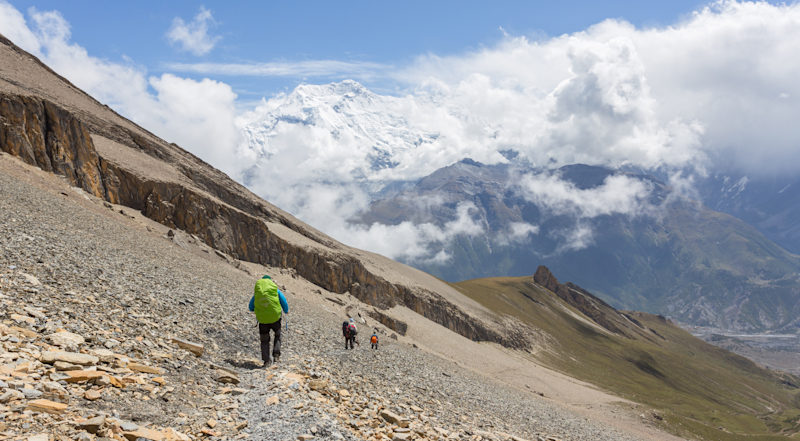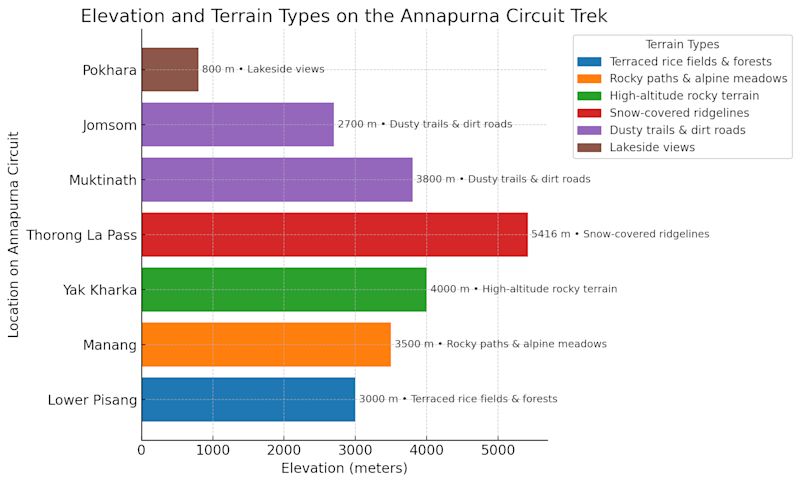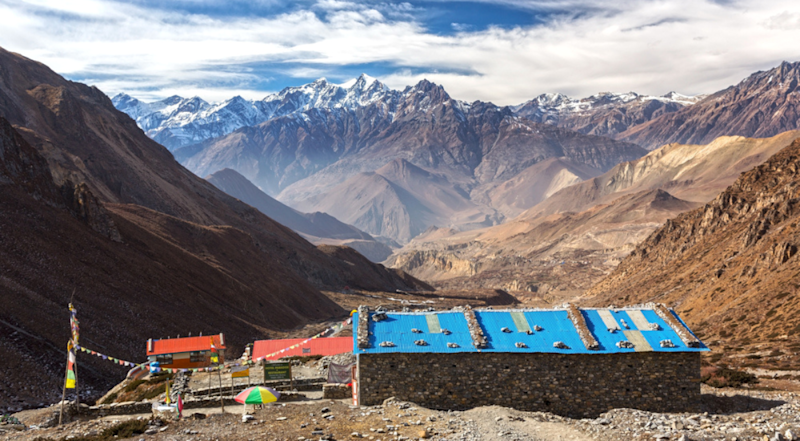How long is the Annapurna Circuit?
So, how long is the Annapurna Circuit, really? The answer depends on your route choices — and how much of it you actually walk. The average length of the Annapurna Circuit hike is 160 km to 230 km (100-145 miles).
This is a significant variation, and here's why.
In recent years, the introduction of dirt roads into the Annapurna region, particularly through the Marsyangdi and Kali Gandaki Gorge, has altered how the walk is approached. Many trekkers now avoid areas by taking jeeps or local buses, reducing overall distance and length.
The classic path from Besisahar to Tatopani or Nayapul is approximately 230 kilometers long and can be completed on foot.
Despite the adjustments, the trail's core remains. The trip continues through terraced farmlands, yak kharkas (grazing pastures), spectacular ridgelines, and culminates at the iconic Thorung La Pass, the hike's highest point at 5,416 meters (17,769 ft).
Whether you change your plan or complete the entire circuit, the Annapurna region is still one of the most rewarding trekking routes in the Himalayas.
What is the length of the Annapurna Circuit in days?
The Annapurna Circuit trek length usually runs between 13 and 20 days, though that depends on your route, hiking speed, and how much time you spend adjusting to the high altitude.
Some trekkers move quickly, especially if they skip sections by jeep or avoid detours. Others take their time, adding in side hikes and rest days to enjoy the landscapes and avoid altitude sickness.
With Follow Alice, the full Annapurna Circuit length is covered in a 13-day itinerary. It’s structured to allow for both altitude acclimatisation and meaningful time on the trekking trail, without feeling rushed.
Here’s a breakdown of what that looks like:
- Day 1: Arrive in Kathmandu.
- Day 2: Drive to Jagat, passing through Besisahar for lunch.
- Day 3: Continue to Lower Pisang, then hike to Upper Pisang for sweeping views of Annapurna II.
- Day 4: Trek to Manang via Nyawal, a beautiful old village on the hillside.
- Day 5: Hike to Kicho Tal, a high-altitude lake near Tilicho Lake — expect a challenge here.
- Day 6: Explore Gangapurna Lake, then visit the local Himalayan Rescue Association.
- Day 7: Head up to Yak Kharka, where the air grows thinner and the views open wide.
- Day 8: Reach Thorung Phedi, the last stop before the big push.
- Day 9: Cross the mighty Thorung La Pass — the trek’s highest point at 5,416 m — and descend to Ranipauwa.
- Day 10: Drive to Jomsom, with a stop in Kagbeni, one of the oldest villages in the Upper Mustang region.
- Day 11: Fly to Pokhara, a lakeside city where you can finally exhale.
- Day 12: Return to Kathmandu.
- Day 13: Departure day.
Want to make the trek longer? You could add a side trip to Tilicho Lake, loop in Poon Hill for a sunrise climb, or explore the arid landscapes of Upper Mustang (a separate but nearby trekking region). If you're pressed for time, it's possible to cut days by flying out of Jomsom or skipping some of the longer hiking sections made more accessible by dirt roads.
No matter your version, hiking the Annapurna Circuit offers some of the most scenic and culturally rich days you'll ever spend on a trekking route — with dramatic climbs, colorful villages, and the constant backdrop of the Annapurna range.
What affects the length of the Annapurna Circuit trek?
There’s no fixed answer to what is the length of the Annapurna Circuit — and honestly, that’s part of the fun. The Annapurna Circuit trek length depends on how much time you have, how adventurous you’re feeling, and whether you’re there to soak in every village or just cross the highest point and call it a win.
Let’s look at what shapes the overall length of the Annapurna Circuit trek.
1. Your starting and ending points
The classic route kicks off in Besisahar, winding slowly through lush foothills and teahouse villages. But thanks to a network of dirt roads, many trekkers now fast-forward to Chame or even Manang by jeep, shaving off multiple hiking days.
On the flip side, where you choose to finish can make a big difference too.
- Traditional start: Besisahar (or Bhulbhule)
- Popular shortcut: Chame or Manang (via jeep)
- Classic end: Nayapul, via Tatopani and Ghorepani
- Common finish: Jomsom, with a flight to Pokhara
Shortcuts save time, but they also skip some of the quieter villages and intimate mountain moments that make hiking the Annapurna Circuit so special. Every detour has a trade-off.
2. Whether you hike or hitch a ride
Since the introduction of jeep roads, it’s now possible to drive portions of the trekking route — especially the lower stretches on either side of the Thorong La Pass.
Some trekkers ride all the way to Manang and later from Muktinath or Jomsom back to Pokhara.
While it trims the itinerary, you also miss out on trail time, interaction with locals, and the quiet beauty between the bigger villages. The Annapurna Circuit length is more than just kilometers — it’s the days you spend walking through changing worlds.
3. Side trips and scenic detours
Want to make your adventure even better? Add a few off-route gems. These detours don’t just increase the length of the Annapurna Circuit — they deepen the experience.
- Tilicho Lake: A surreal turquoise lake perched at 4,919 m. Adds 3–4 days, totally worth it.
- Kicho Tal (Ice Lake): A perfect high-altitude acclimatisation hike from Manang.
- Upper Mustang: A detour into the mystical “Forbidden Kingdom” north of Muktinath. Requires a separate permit.
- Poon Hill: Wrap up the trek with a view of Annapurna at sunrise that feels straight out of a painting.
These additions might stretch the trip, but they bring wild landscapes, local tea houses, and photo ops you’ll be bragging about for years.
What kind of terrain and elevation gain can you expect?
The Annapurna Circuit isn’t just long — it’s epic in every sense. You’ll pass through terraced rice fields, rhododendron forests, alpine meadows, barren plateaus, and eventually, snow-covered ridgelines near Thorong La Pass.
Elevation starts low and ends way, way up. Here’s how the trail climbs:
The trekking trail varies. One moment it's a soft forest path, the next it's a rocky screen near a glacial moraine. Expect suspension bridges, dusty climbs, and, yes, the occasional encounter with a jeep on the dirt road sections — mostly on the way down. But the higher you go, the quieter and more pristine it becomes.
High altitude and acclimatisation
The Annapurna Circuit trek takes you deep into high-altitude territory — and that comes with responsibility. Once you cross 3,000 m (9,843 ft), the risk of altitude sickness creeps in, especially if you move too quickly.
That’s why smart trekkers build in acclimatisation days — usually around Manang, where the air gets thinner and the tea houses are cozy.
Here’s how to play it safe:
- Stick to the “climb high, sleep low” principle
- Don’t rush rest days — especially in Manang
- Drink water like it’s your job
- Carb-load, even if it means yak-cheese pizza
- Watch for signs of AMS: headache, nausea, loss of appetite, dizziness
Fun fact: Everest Base Camp is at 5,364 m (17,598 ft). On the Annapurna Circuit, you’ll cross that altitude at Thorong La Pass — meaning it’s not just a destination, it’s a literal high point you have to summit and descend in one go. For more comparisons between these treks, click here.
Life on the trail: Tea houses and daily distances
One of the absolute best things about the Annapurna Circuit trek? You don't have to lug around a tent or stockpile a week's worth of food. Instead, you're treated to the charm of tea houses—quaint local guest houses scattered along the route. These are more than just a place to rest your legs; they’re where you’ll refuel with hot meals, warm beds, and if you're lucky, a hot shower to refresh after a long day on the trail.
The beauty of the Annapurna Circuit trek length is that you can adjust your daily distances based on how you're feeling. Some days, you'll want to go further, while others, you'll be satisfied with fewer distances as you adjust to the high altitude. You are in control of your own pace.
Understanding daily trekking distances
So, how long is the Annapurna Circuit hike in terms of walking distance per day? It depends! The trek varies by elevation, terrain, and how well you're adjusting to the altitude.
Here’s a breakdown of what you can expect:
- Short days (8–10 km / 5–6 mi): When you’re climbing up toward Yak Kharka or approaching the steep ascent to Thorong La Pass, the going can be slow. The days will be shorter, but that’s because the terrain is tough and you're likely already high up in the Annapurna range.
- Medium days (12–15 km / 7–9 mi): As you make your way through more gradual climbs and descents, like those near Manang, you can tackle these moderate distances. These are great days for taking in the jaw-dropping views of Annapurna, Tilicho Lake, and the surrounding peaks.
- Long days (20+ km / 12+ mi): On the long days, you're either descending or trying to catch up on time. You may pass through dusty dirt roads or make your way toward the tranquil Upper Mustang. These stretches can be tiring, but there’s always something rewarding about covering extra distance with a sense of accomplishment.
The length of the Annapurna Circuit trek isn’t just about hitting those miles — it’s about how many hours you’re walking and how your body reacts to the higher altitudes. After all, hiking at 5,400 meters (17,700 feet) over Thorong La Pass requires a lot more than just stamina!
The best time to trek the Annapurna Circuit
Planning your Annapurna Circuit trek isn’t just about booking flights and packing up; you’ve got to consider timing. The weather on the trail changes with the seasons, so the best trekking conditions are critical.
Here’s what you need to know:
Ideal trekking months
- Autumn (late September to November): If you’re dreaming of a perfect trek with clear skies, crisp mornings, and brilliant views of the Annapurna range, autumn is your golden window. The trails will be busy with fellow trekkers, but the scenery is worth it. Think about getting that shot of Tilicho Lake under the blue skies or experiencing the breathtaking view of Annapurna II. And if you’re feeling up to it, here are ten more things to do in Nepal during these months.
- Spring (March to early May): Spring is a close second. The weather is pleasant, and the rhododendron forests that line the trail are in full flower. You won't find the big throngs of October, but the vistas are still breathtaking. You might even see a yak grazing as you walk through the lower valleys.
What to avoid while walking the Annapurna Circuit
- Winter (December-February): As appealing as a winter journey for isolation may sound, the Annapurna Circuit trek should not be attempted during the winter months. Heavy snow and cold temperatures can close critical parts like Thorong La Pass, not to mention the scarcity of tea houses and the dangers of altitude sickness at those frigid heights.
- Monsoon (June-early September): This is the wet season in Nepal, and not only does it bring muddy trails, but it can also obscure views with thick clouds. Plus, there’s the joy of leeches in some sections! If you’re hoping for stellar views of the Everest Base Camp or the iconic Annapurna range, the monsoon is a season best skipped.
If you’re dreaming of crystal-clear views of Thorong La Pass, bright skies over Tilicho Lake, and making your way through lush forests or Poon Hill, then autumn is definitely your best bet. But don’t rule out spring if you’re in the mood for a bit of quieter trekking. Just be mindful of your weather window, and pack well. You’ll be all set for an unforgettable adventure.
Annapurna Circuit length at a glance
- Annapurna Circuit trek length: 160–230 km (99–143 mi), depending on the route and side trips
- Typical duration: 15–20 days on average
- Highest point: Thorung La Pass at 5,416 m ( 17,769 ft) — acclimatisation is essential
- Add-on detours: Tilicho Lake, Ice Lake, Poon Hill, and Upper Mustang
- Trekking route changes: Dirt roads now bypass some sections, but the classic trail is still intact
- Support along the way: Tea houses in nearly every village — hot meals, warm beds, and yak sightings included
Embrace Your Annapurna Adventure
If you're still wondering what the length of the Annapurna Circuit is, here's the thing: it’s not just about the distance. It's about how each stretch feels.
This is one of the world’s most iconic trekking trails for a reason. One day you’re crossing high-altitude passes, the next you’re sipping tea below Annapurna II. The trail winds through alpine deserts, subtropical valleys, and villages carved into the cliffs — and with every step, the scenery shifts.
Sure, the Annapurna Circuit length has technically shortened in places, thanks to newer roads. But the adventure? Still massive. Whether you're pushing to High Camp, catching a sunrise over the Annapurna range, or adjusting your pace at Yak Kharka to dodge altitude sickness, this trek gives you the freedom to go slow, go high, or go big.
The beauty of it is that you don’t need to be hardcore. Just curious. And maybe a little stubborn.
So if you're dreaming of hiking the Annapurna Circuit, here's your sign to go.
Let us guide you through it all — the logistics, the altitude, the tea houses, the unforgettable moments. Join our Annapurna Circuit trek and experience the Himalayas the way they’re meant to be explored.






